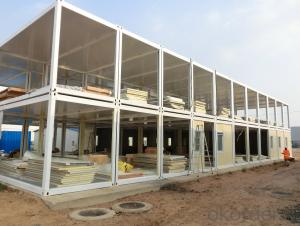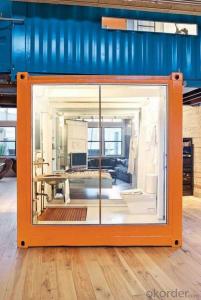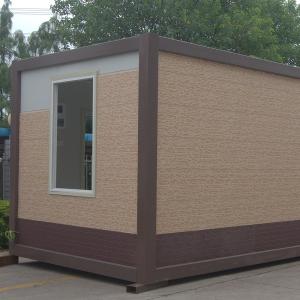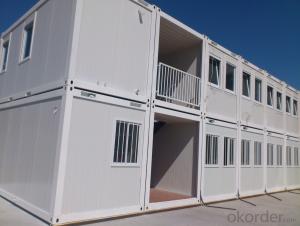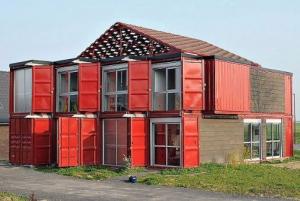Container Accommodation G+1 Sandwich Panel House Modular House
- Loading Port:
- China Main Port
- Payment Terms:
- TT or LC
- Min Order Qty:
- 7 set
- Supply Capability:
- -
OKorder Service Pledge
OKorder Financial Service
You Might Also Like
Top 10 Prefab House Container for Mining Accommodation
| Size | External | 6058mm(L)* 2438mm(W)* 2591mm(H) |
| Internal | 5820mm(L)* 2200mm(W)* 2375mm(H) | |
| Color | Standard: White | |
| Steel Frame | 3mm (Hot-galvanized) | |
| Wall | 60mm EPS sandwich panel | |
| Roof | 1st layer | 50mm EPS sandwich panel |
| 2nd layer | 100mm thermal insulation | |
| 3rd layer | Galvanized roof tile | |
| Floor | 1st layer | Hot-galvanized steel sheet |
| 2nd layer | 20mm XPS board | |
| 3rd layer | 10mm cement board | |
| 4th layer | Vinyl Floor | |
| Door (1pc) | Steel security door (with keys) | |
| Size- 900mm*2100mm | ||
| Window (2pcs) | Sliding PVC windows: Size--800mm*1100mm (2pc) | |
| Electricity | Distribution box*1 | |
| Circuit break*1 | ||
| Ceiling Lights*2 | ||
| Sockets*3 | ||
| Switch*1 | ||
| Local standard cables | ||
| Water pipes | Local standard supply and drainage pipes | |
b) Accessories
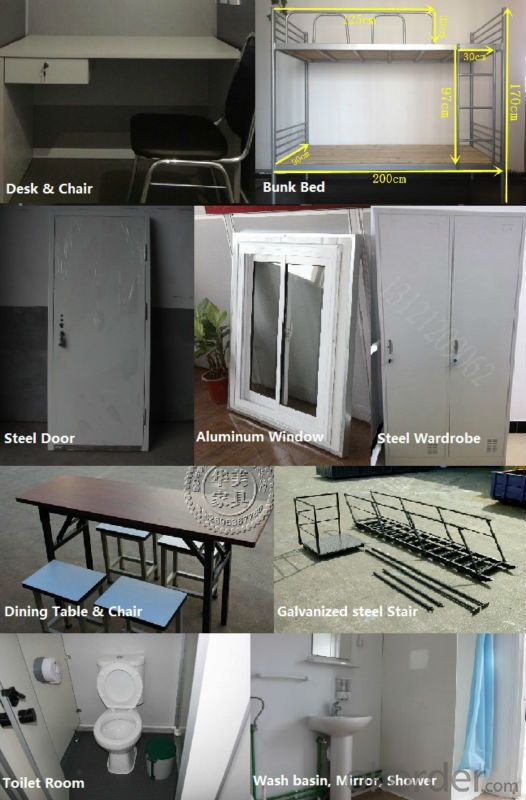
2. Workforce Camp Application of Flat Pack Container House
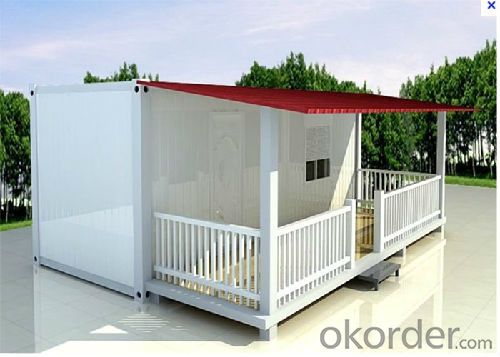
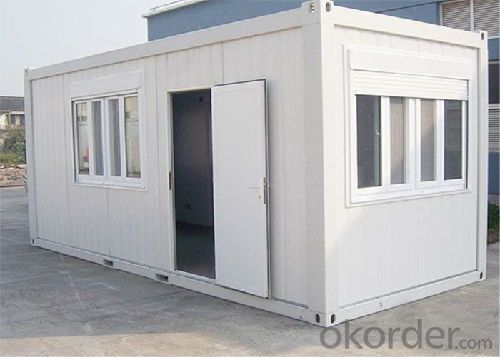
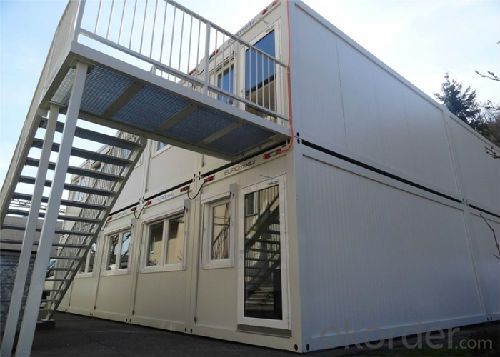
3. Installation
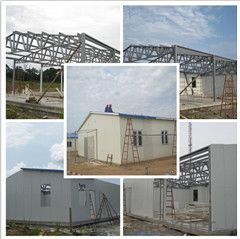
4. Packing and Delivery
Flat pack container houses are designed to be the same size of 20' shipping containers so that it's unnecessary to be loaded into shipping containers.
Every 4 units will be packed and treated as 1*20'SOC. Therefore, 1 unit only costs 1/4 of a 20GP's freight.

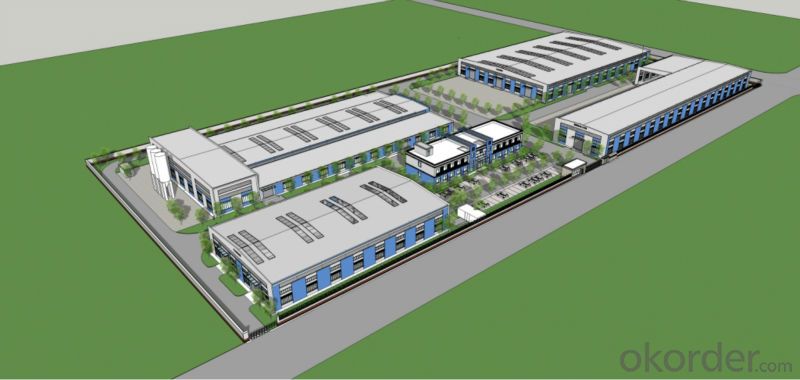
We provides professional workforce/labor camp solutions using flat pack container system.
Any enquiries, please don't hesitate to contact us!
5. FAQ
1. Q: How much is this house?
A: Please provide with your house drawing and project location, because different design, different location effect the house materials quantity and steel structure program.
2. Q: Do you do the turnkey project?
A: Sorry, we suggest customer to deal with the foundation and installation works by self, because local conditions and project details are well knowb by customers, not us. We can send the engineer to help.
3. Q: How long will your house stay for use?
A: Our light steel prefab house can be used for about 70 years.
4. Q: How long is the erection time of one house?
A: for example one set of 200sqm house, 8 workers will install it within 45 days.
5. Q: Can you do the electricity,plumbing and heater?
A:The local site works had better to be done by the customers.
- Q:What are the different sizes of container houses available?
- To accommodate different needs and preferences, container houses are available in various sizes. The standard lengths used in shipping are 20-foot and 40-foot containers. A 20-foot container house typically provides approximately 160 square feet of living space, while a 40-foot container house offers around 320 square feet. However, these sizes can be altered and combined to create larger spaces. For example, some container houses are constructed by joining two 20-foot containers together, effectively doubling the living area to 320 square feet. Additionally, multiple containers can be stacked or connected to create multi-level or more spacious homes. Furthermore, container houses can be personalized by adding features such as decks, balconies, and extensions, which further expand the available living space. These modifications allow for flexibility in design and allow individuals to customize their container houses according to their specific requirements. It's important to note that although the aforementioned sizes are commonly used, container houses can also be built using smaller or larger containers depending on the desired outcome. The size of a container house ultimately depends on factors such as budget, purpose, and the number of occupants.
- Q:Can container houses be easily transported?
- Yes, container houses can be easily transported. They are specifically designed to be moved and transported using cranes, trucks, or ships. The standardized dimensions of shipping containers make them easy to handle and transport, allowing container houses to be relocated to different locations quickly and efficiently.
- Q:Can container houses be designed to blend with the surrounding environment?
- Yes, container houses can be designed to blend with the surrounding environment. With proper planning and design, container houses can be customized to harmonize with the natural landscape or complement the existing architectural style of the area. Here are a few ways container houses can be designed to blend seamlessly with their surroundings: 1. Material selection: Opting for natural and sustainable materials, such as wood or stone finishes, can help the container house blend with the natural environment. These materials can be used for cladding or as accents to soften the industrial look of the containers. 2. Color palette: Choosing earthy tones, muted colors, or shades that match the surroundings can make the container house visually blend into the environment. This can be achieved through painting, using natural pigments, or employing camouflage techniques like incorporating plants or green roofs. 3. Landscape integration: Incorporating landscaping elements around the container house can enhance its integration with the surroundings. This can include planting trees, shrubs, or creating gardens that complement the natural features of the area. 4. Design adaptation: Modifying the container house's design to mimic the local architectural style can help it blend better with the surrounding environment. This could involve adding traditional elements, such as pitched roofs, porches, or balconies, to create a harmonious integration with nearby structures. 5. Orientation and placement: Properly positioning the container house on the site can maximize its relationship with the surrounding environment. Orienting windows and openings to capture scenic views or natural sunlight can create a stronger connection between the house and its surroundings. Ultimately, the design possibilities for container houses are endless, and with thoughtful planning, they can be tailored to blend seamlessly with their surroundings. By utilizing appropriate materials, colors, landscaping, and design adaptations, container houses can become an integral part of any environment while still maintaining their unique and sustainable character.
- Q:Can container houses be designed with a home office or studio?
- Yes, container houses can absolutely be designed with a home office or studio. In fact, the versatility and flexibility of container homes make them ideal for incorporating dedicated workspaces or creative studios. With careful planning and design, containers can be transformed into functional and comfortable spaces to accommodate various needs. Container homes can be customized and modified to include features such as large windows for natural light, proper insulation for soundproofing, and efficient ventilation systems to ensure a comfortable working environment. They can also be designed with ample storage space, built-in desks, and shelving units to maximize functionality and productivity. Furthermore, container homes offer the advantage of being modular, which means additional containers can be added to create more space as needed. This allows for the expansion or reconfiguration of the home office or studio over time, adapting to changing requirements. Additionally, containers can be modified to suit specific aesthetic preferences and design styles. From rustic to modern, container homes can be customized with various finishes, materials, and architectural elements to create a unique and inspiring workspace. Overall, container houses offer a cost-effective and sustainable solution for those seeking a home office or studio. They provide the flexibility to design and create a dedicated workspace that meets individual needs, all while embracing the innovative and eco-friendly nature of container architecture.
- Q:Are container houses suitable for music studios?
- Indeed, container houses can serve as appropriate settings for music studios. The versatility and cost-effectiveness of these dwellings have contributed to their increasing popularity. They can be easily modified and customized to cater to specific requirements, rendering them ideal for a multitude of purposes, including music studios. Container houses furnish a robust and soundproof environment, a crucial aspect for any music studio. The steel walls of these containers furnish exceptional insulation against external noise, guaranteeing that sounds produced within the studio do not disturb the surroundings, and vice versa. Moreover, containers can be effortlessly equipped with suitable insulation materials, such as acoustic foam panels or soundproof glass, to further enhance the audio quality within the studio. Consequently, musicians and producers can compose and record music without unwanted external noises or disturbances. Furthermore, container houses can be conveniently expanded or combined to create larger studio spaces, accommodating multiple recording rooms, control rooms, and even lounges or waiting areas. This adaptability permits future growth and the capacity to adjust to evolving needs. Container houses also prove cost-effective when compared to conventional construction methods. They are easily accessible, and their modular nature simplifies the construction process, reducing both time and expenses. As a result, musicians and artists with limited budgets can acquire their own professional spaces for music production and recording. All in all, container houses offer a pragmatic and efficient solution for music studios. They bestow soundproofing, flexibility, and cost-effectiveness, rendering them a suitable choice for musicians, producers, and anyone seeking to create a professional music environment.
- Q:How big is the container type?
- Second, durable, all composed of steel, with a strong anti-seismic, anti-deformation ability
- Q:Are container houses suitable for outdoor adventure or glamping accommodations?
- Container houses are an ideal option for outdoor adventure or glamping accommodations. They are versatile and can be easily transported to remote locations, making them a great choice for outdoor enthusiasts. Moreover, they offer a distinctive and environmentally-friendly alternative to traditional structures, providing a comfortable living space for those who love the outdoors. Customization is another advantage of container houses. They can be tailored to meet specific needs and preferences, allowing for a harmonious blend of nature and modern amenities. With proper insulation, ventilation, and plumbing systems, container houses can provide a cozy environment even in extreme weather conditions. Additionally, their sturdy construction ensures durability and resistance to natural elements, making them suitable for various outdoor settings. Furthermore, container houses can be designed with large windows and open floor plans, maximizing natural light and offering breathtaking views. This creates a strong connection with the surrounding environment, enhancing the overall outdoor adventure or glamping experience. Additionally, they can be equipped with innovative features such as solar panels, rainwater harvesting systems, and composting toilets, further enhancing their sustainability and eco-friendly appeal. In conclusion, container houses are an excellent choice for outdoor adventure or glamping accommodations. They offer versatility, durability, and sustainability, providing a comfortable and unique living space that seamlessly integrates with the natural surroundings. Whether for a short weekend getaway or a long-term stay, container houses can create a memorable and enjoyable outdoor experience.
- Q:Can container houses be expanded or modified?
- Yes, container houses can be expanded or modified. Due to their modular nature, containers can be easily added or removed to increase or decrease the size of the house. Additionally, they can be modified by adding windows, doors, partitions, or even combining multiple containers to create larger living spaces. This flexibility makes container houses highly adaptable to changing needs and preferences.
- Q:How do container houses compare to traditional houses in terms of cost?
- Container houses generally tend to be more cost-effective compared to traditional houses. This is primarily due to the fact that containers, which are the primary building material for these houses, are widely available at lower costs. Additionally, the construction process of container houses is often faster and requires less labor, further reducing the overall cost. However, it's important to note that the final cost may vary depending on factors such as location, design, modifications, and additional amenities.
- Q:Are container houses suitable for artist studios?
- Yes, container houses can be suitable for artist studios. Container houses are versatile and can be customized to meet the unique needs of artists. They provide a cost-effective and eco-friendly alternative to traditional studio spaces. Containers can be easily transformed into spacious and well-lit studios by adding windows, skylights, and insulation. Their modular nature allows for easy expansion or modification as the artist's needs change over time. Additionally, container houses can be placed in various locations, providing artists with the opportunity to work in inspiring and secluded environments. The durability of container houses ensures that they can withstand the wear and tear that comes with artistic endeavors. Overall, container houses offer a practical and creative solution for artists in need of a suitable studio space.
1. Manufacturer Overview |
|
|---|---|
| Location | |
| Year Established | |
| Annual Output Value | |
| Main Markets | |
| Company Certifications | |
2. Manufacturer Certificates |
|
|---|---|
| a) Certification Name | |
| Range | |
| Reference | |
| Validity Period | |
3. Manufacturer Capability |
|
|---|---|
| a)Trade Capacity | |
| Nearest Port | |
| Export Percentage | |
| No.of Employees in Trade Department | |
| Language Spoken: | |
| b)Factory Information | |
| Factory Size: | |
| No. of Production Lines | |
| Contract Manufacturing | |
| Product Price Range | |
Send your message to us
Container Accommodation G+1 Sandwich Panel House Modular House
- Loading Port:
- China Main Port
- Payment Terms:
- TT or LC
- Min Order Qty:
- 7 set
- Supply Capability:
- -
OKorder Service Pledge
OKorder Financial Service
Similar products
New products
Hot products
Related keywords
